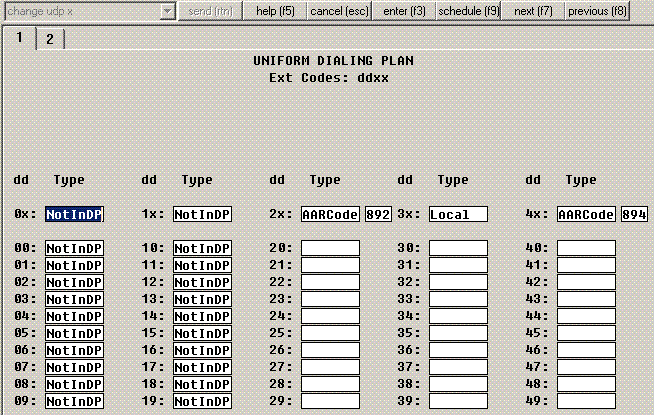
Content of the UDP table can be recalled with a "List UDP" command:

| Parameter | Description | Range of possible values |
|---|---|---|
| Extension codes | Input of the table. Dialing number range. | x - wildcard |
| Type | ||
| Node Number | ||
| Location Code | Output of the table. Route code. | The value is the input of the route selection table (AAR Digit Analysis). |
Command: ch udp x;
An example for programming of location codes:

Uniform Dialing Plan Report
Extension Codes Type Node Number / Location Code
2xxx -VOIP AARCode 892
3xxx -211 Local
4xxx -213 AARCode 895
5xxx -214 AARCode 894
8xxx -gergo AARCode 893
^
|AAR prefix
Type: AARCode, Local, ENPCode, TempOOS, UDPcode
Dialing plans:
UDP - Uniform Dialing Plan
UDPcode/AARcode
ENP - Extension Number Portability code
PNA - Private Network Address
AAR - Automatic Alternate Routing (PNA+UDP) (access code: 8)
ARS - Automatic Route Selection (access code = 9 (US) 0 out of US)
9 + 1 + (212) - 201 -1234
^ ^
| | ARS prefix
ARS access code
Bibliography: Implementation 6-117
Features for the customer to choose the location of extensions and control
the routing of calls:
UDP
AAR
ARS
Network addresses:
PBX code: 1...5 digit of the dialing number with 4 or 5 digits
RNX: it is in connection with the PBX code and it is used for selction of AAR pattern.
RNX is with 3 digits, and it could be an AAR location code, or an ENP code in
case of ENP calls.
RN, RNX, RXX dial plans
ECS -
PBX ID (1..63) - Identifier of the exchange.
RNX - R=2..9 N=0..9 X=0..9
ETN address DCS UDP 7 digit - network address
| |-----------|
location code extension number
3 digit 4 digit
RNX XXXX
^
| Firts digit cannot be 0
UDP is used as ETN, M/S/T, DCS
ETA - Extended Trunk Access
ETA - Enhanced Terminal Administration
ENP - Extension Number Portability (steering -irányítás)